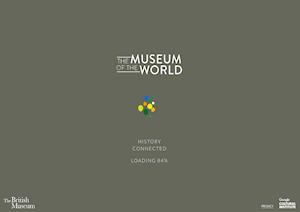
Joukowsky Institute for Archaeology and the Ancient World/Department for Earth, Environmental, and Planetary Sciences, Brown University, RI 02912, USA. Email: samantha_lash@brown.edu
Publication date: 4 May 2017
Cite this as: Lash, S. 2017 Review of The Museum of the World [website], Internet Archaeology 44. https://doi.org/10.11141/ia.44.14
The British Museum: https://britishmuseum.withgoogle.com/
The British Museum, in partnership with the Google Cultural Institute, has developed a digital interface featuring selected objects from their collections: The Museum of the World. The mission of the project is to make knowledge and culture of the 'whole of humanity' available to all as a Museum of and for the World (MacGregor 2015). This impressive effort pushes the bounds of what digital heritage can be, but also raises important questions about the role of the museum, public interaction, and the presentation of world history. The Museum of the World microsite uses the Web Graphics Library (WebGL), the JavaScript API to render interactive Shader-based 2D computer graphics with any compatible web browser (supported by major browser vendors including Apple, Google, Mozilla, and Opera). WebGL is the integrated web standard for plugin-free 3D graphics wherein image processing is integrated into the web page canvas in the browser; additional functionality is provided by Javascript libraries including popular game engines Unreal Engine 4 and Unity 5. The interface was built by Weir+Wong, a London-based creative digital production company; introductory sound was provided by FreeSFX.co.uk.

As the interface loads (rapidly), the page shows a growing number of colored dots with the text 'History connected' amidst them (Figure 1). As the dots shudder, they explode with a crescendo of sound, and constellations begin to connect the dots (Figure 2), which settle on the main page (Figure 3).
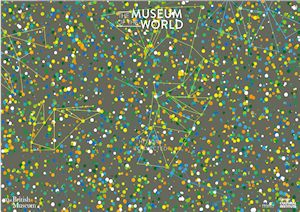
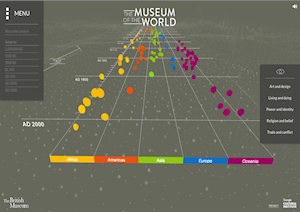
In an exercise of brevity, The Museum of the World describes itself, in a pop-up 'About this project', as an 'interactive experience through time, continents and cultures' (Figure 4).
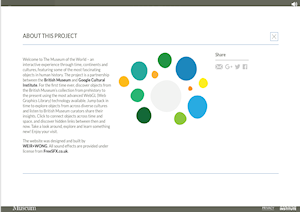
The main screen features an interactive timeline which spans from roughly two million years ago to the present day and is divided into 'tracks' on which five difference colored sets of dots sit, representing geographic origin Africa (yellow), Americas (orange), Asia (green), Europe (blue), and Oceania (purple) from left to right (Figure 3). The only time one navigates away from this main screen is by following the links along the bottom to the British Museum, the Google Cultural Institute, and Google's privacy policy. Along the left side of the screen is a menu, which allows one to 'jump' in chronology and houses the 'About this project' link, an option to share content on social media, and two arrow keys to toggle the timeline. Along the right side of the screen is an inset marked with an eye, or 'browse' indicator, which features five themes. These five predetermined themes serve to differentiate the objects, including Art and Design, Living and Dying, Power and Identity, Religion and Belief, and Trade and Conflict. By clicking on the theme on the right panel, only the objects associated with it will remain in the timeline. While I very much appreciated that this thematic effort nuances their presentation of world history and individual objects, the viewer is left to their own devices to reason out the supposed connections. There is no narrative to guide the choice of the theme, the relevance of the objects to it, nor an argument that articulates the usefulness of such a framework.
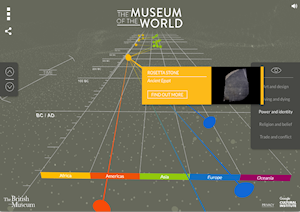
Each dot hovering along these tracks represents an object in the British Museum collection, clicking on the blob draws a series of links to other dots and offers an image, identification, cultural affiliation, and a 'Find out More' button (Figure 5). Clicking on this brings you to a pop-up page which features the object image, a object description about the object both in writing and read in an audio recording, a Google map of an associated locale, and a series of 'related objects', along with the typical suite of social media 'share buttons' (email, Google+, Twitter, and Facebook) (Figure 6).
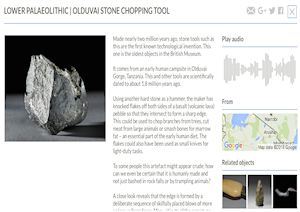
| Earliest | Latest | Total | Art & Design | Living & Dying | Power & Identity | Religion & Belief | Trade & Conflict | |
|---|---|---|---|---|---|---|---|---|
| Africa | 1.8mya | 1990s? | 58 | 18 | 15 | 11 | 10 | 4 |
| Asia | 3100-3000 BC | 1912 | 113 | 27 | 19 | 23 | 29 | 15 |
| Europe | 2700-2400 BC | 1898 | 87 | 25 | 24 | 9 | 8 | 21 |
| Americas | 1000-400BC | 1900s | 31 | 2 | 15 | 7 | 6 | 1 |
| Oceania | AD 1774 | Present day | 30 | 6 | 6 | 5 | 6 | 7 |
There are a total of 319 objects represented by colored dots in the tracks (see Table 1). It remains unclear if the objects are limited to those from exhibitions, or if these include those that may be in storage, on loan, in teaching collections, etc. The objects range temporally from an Olduvai stone-chopping tool from the Lower Palaeolithic, dating to approximately 1.8mya (Figure 6), to examples from the present day. The latter are geared less so towards modern art, most are examples of 'indigenous' cultural items, or a mix of the two such as the 'Man's Cloth' by the artist El Anatsui (Figure 7).
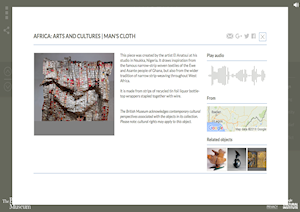
The object 'pop-up' is well thought out, including both a written and audio version of a curator's commentary on the given subject, however some are missing key pieces of information such as an approximate date or an explanation of why such key details may be absent due to issues of provenance or transmission. These object descriptions vary broadly: while some are nearly purely descriptive, many include thematic, methodological, or other relevant issues. These latter insights promote users to think about the objects, where they came from, how they connect to one another, as well as the world around us today. The Kilwa Kisiwani potsherds, catalogued in Mack (2001) serve as an example (Figure 8). These ceramics were found in the town of Kilwa Kisiwani in Tanzania, and include locally made wares as well as ceramics produced as far away as China and the Middle East. The object description not only describes the fragments and how their characteristics indicate their origin but also how these ceramics represent the function of the town as an important port on the Indian Ocean between CE 1000 and 1500. This kind of narrative, touching on issues of transport, trade, cultural interaction, and refuse deposition, gives users a glimpse of how archaeologists and historians make sense of the past, the types of information we glean from material culture, and how we connect physical objects to interpretations about human activity, occupation, and experience. Some object descriptions also discuss how the object was acquired, comparanda, how it might have functioned in its original context, how it was made, and even how it has been conserved in the museum (e.g. a mosaic column from Tell al-'Ubaid (Figure 9), or the Cypriot Limestone 'Temple Boy').
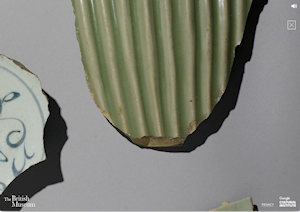
The usefulness of the map in the object pop-up varies with the certainty of the provenience (site vs. region). The images are high resolution and can be expanded and examined under magnification (Figure 8).
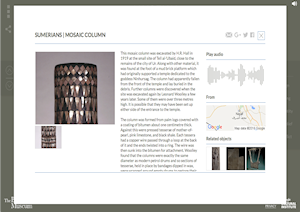
The Related Objects Feature is an innovative element, which again promotes users to think about connections that can be drawn between objects and the types of themes and issues that they may serve to illustrate. What defines the relatedness between objects is often maintained through the three examples provided for a given object, but varies between objects. For example, the milestone from Roman Britain near the fort at Caerhun erected under Hadrian, is linked to the Leadenhall Street mosaic a 1st-2nd century CE Romano-British roundel featuring Bacchus and a tigress, a tablet preserving a line from Virgil from the Vindolanda fort (both from the northern frontier of Roman Britain), as well as an Iron Age horse harness from the Stanwick Hoard buried during the Roman conquest of southern Britain. While these four objects are tied together by their geographic, chronologic, and historical circumstances, not all of the objects in the collection are indexed in this way. The related objects linked to the mosaic focus on the artistic medium - a column from Tell al-'Ubaid dating roughly to 2500 BCE and a 14th-16th century CE Mexica (Aztec) serpent ornament. Objects linked to the Vindolanda tablet include several examples of ancient text - a Sumerian clay tablet about daily rations, the famous Rosetta Stone, and a bilingual diplomatic tablet between Syria and Egypt from El-Amarna 14th century BCE). The horse harness fittings are grouped with related objects by association with horses including Bronze Age crotal bells from Ireland, a late Kofun period gilt-copper harness fitting from Japan (Kofun period is ca. 250-538 CE), and an Iron Age bronze model of a horse's head found out side of Stanwick, England (ca. 50BCE to CE 100).
The project seems to be inspired by a desire to think across the collections at the British Museum by establishing connections between objects from different times and geographic regions. This is in line with the museum's overall mission as recently articulated by then Director Neil MacGregor: 'to be a Museum of and for the World, making the knowledge and culture of the whole of humanity open and available to all' (MacGregor 2015). However, there is little framing of the project within the context of this broader mission and the museum's other resources (see below). The lack of objectives and description detracts from the effectiveness of the project. This is particularly noticeable in the lack of a discussion on the presentation of global heritage and world history. As globalization continues to increasingly frame our worldview, the orientation of many museums has shifted from the establishment of a national identity towards that of global ambassador, often with little critical discussion or reflexivity. Andrew Sayers, the director of the National Museum of Australia, noted this phenomenon in a 2010 speech 'Museums and their Place in the World'. He touches on a broad range of issues including national identity and imperialism, the concept of 'world museums', soft diplomacy, the presentation of indigenous culture, and repatriation, that are often absent from leading institutions global claims and objectives.
The name and concept of the project reinforces this broader global agenda of the British Museum, and highlights the lack of discussion on these associated issues. While I would not anticipate the microsite to feature a lengthy digression, a single 'about this project' paragraph is insufficient, particularly given the complicated histories of the museum and its collection as well as the broader discipline evident in ongoing repatriation debates and the perception of the museum as a 'quintessential imperial institution' which MacGregor has addressed directly (see Duthie 2011 on the museum as a trope of empire). Because the objects span almost two million years of world history and are limited to the collection of a single (albeit vast) museum collection, the project is underwhelming in its representativeness of world history without further framing. While the objects are fairly illustrative of their collection, particularly in geographic distribution, there is no expressed intent or plan to add more entries and expand the effort. Returning to the early extent of the timeline, there is another Olduvai lithic, a handaxe dating ca. 1.5mya, and then the next dot represents the 14-13kya Jebel Sahaba cemetery in Sudan. This is a large, although unsurprising, gap, which marks yet another point in this experience which would have been well-served by either an accompanying text or supplementary information (Figure 10).
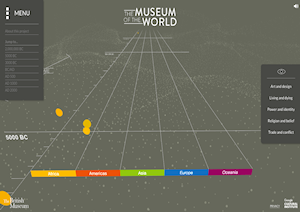
Generally, the gaps and clusters of the objects on the timeline are what one might expect of a 'greatest hits' album. While it is to be expected that a timeline of the museum objects might inherit the biases of the collection itself, large parts of which were acquired decades ago, the presentation of the interface as The Museum of the World cements an outdated and simplified perception of global human history. The division of the world in geographic monoliths, again an understandable choice, does little to abate this chronological disparity; in fact the combination of the two without discussion contributes to the perpetuation of stereotypes. For example, the 'Oceania track' only extends back to the third quarter of the 18th century BCE, obscuring millennia of human migration and island colonization (see Fitzpatrick 2004; Veth 2007). An accompanying narrative and description of the project objectives would be a welcome remedy and contribute much to ongoing conversations regarding the meaning of world history, global heritage, and the like.
The flipside of the 'global' coin, is the leaps and bounds the British Museum has made over conventional museum outreach and web-presence, particularly in terms of accessibility. While the various digital efforts of the British Museum are briefly outlined below, it should be noted that there are subtle features exemplified in The Museum of the World project, which expand the potential user base. For instance, the object descriptions are accompanied by an audio reading of the text. This makes much of the encoded information both available to the deaf community and usable in a classroom setting of all ages.
The British Museum has a longstanding history of developing digital components and products. These include software such as 'World of Money' (1998; see de Jersey 1998), an interactive exploration of money worldwide from ancient times through present day, and Journeys in the Roman Empire (2001; see Osgood 2002), a joint collaboration with the Verulamium Museum, St Albans in Hertfordshire, England, and Channel 4 education.
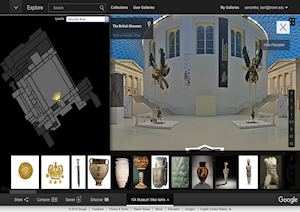
Today, there are several ongoing digital projects at the British Museum, yet despite being powered largely by Google, they don't seem to be well integrated or interconnected . These include a 'Museum View' (Figure 11), similar to Google Map's 'Street View', 'Zoom Views' (part of the slightly earlier Google Art Project which launched in 2011 featuring high-resolution of select artworks from museums in over 40 countries) (Figure 12), a commitment to electronic publishing (Strudwick 2004), and virtual exhibits.
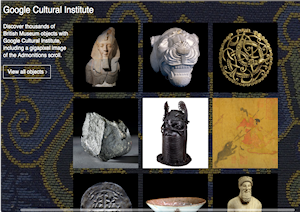
There are currently eight virtual exhibits based at the British Museum, ranging from Sicily: Culture and Conquest to Social Fabric: African Textiles Today, to Poetry and Exile, and in total including approximately 4,656 items to date (Figure 13).
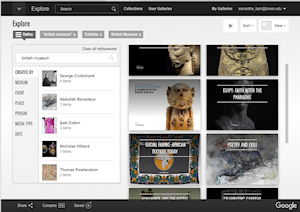
Most impressive on the part of the British Museum is their extensive digital catalog with over 2,273,461 available records, representing more than 3,500,000 objects, of which 949,863 have one or more images as of May 14th 2016 . This database is well integrated into a growing body of linked published data around the world.
It is difficult to place The Museum of the World in context of these British Museum collaborative projects. The interface is interactive in a basic sense, but the platform does not allow users to do or create anything per se. This is in contrast to the ability to 'create galleries', for example, on the Google Cultural Institute's main page , or the plethora of the British Museum's learning resources that facilitate user content creation. The idea of networks and connections are visually reinforced through The Museum of the World project in the 'History Connected' Introduction and the constellations or networks formed when you click a dot. However, the 'edges', or links, themselves serve the aesthetic purpose to identify a pre-determined thematic group but offer no further information or rationale. There is enormous potential here to formally integrate The Museum of the World with these other projects and increase its functionality. While The Museum of the World interface is certainly aesthetically pleasing and fun to browse, in light of the extensive resources available for classroom teaching, researchers, and the variety of digital content already supported by the British Museum and the Google Cultural Institute, I wonder how The Museum of the World is intended to complement their repertoire.
It is of note that The Museum of the World comes on the heels of a different joint project, A History of the World in 100 Objects, a joint project between the British Museum and BBC Radio 4. This project was a 100-part radio series written and presented by then British Museum director Neil MacGregor . From January 2010 the series ran for 20 weeks, objects were used to introduce and discuss episodes in human history in fifteen-minute pieces. The multi-platform programming was accompanied by nationwide activities with partner museums across the UK, online resources, and a feature for the public to upload and comment on their own objects. While there is no crossover or linkage between the projects in terms of resources or format, there is certainly in the form of content. Many of the objects, which appeared in this earlier series, also feature in The Museum of the World, for example the Kilwa potsherds . It is worth mentioning that a review of the A History of the World in 100 Objects project also was drawn to the Kilwa potsherds as an example of what the British Museum does so well (Lambourn 2011). While there is much room for improvement in terms of a discussion of the presentation of world history and global heritage, the British Museum continues to excel at featuring not only the 'high art so often selected when artifacts are used in history' (Lambourn 2011, 530), but the fundamental types of material culture that enable archaeologists and historians to understand complicated historical narratives and phenomena. This is seen in the related objects feature as it offers a variety of insights into how objects might be related and the kinds of information one may glean from them. This feature not only relates objects based on geopolitical and temporal contexts, but also those separated by thousands of miles and millennia which are related in function, production technique, or represent broader ideas and activities. This is well in line with the 'material turn' in thinking throughout humanities and social sciences (Hicks 2010). While the The Museum of the World is undoubtedly a success in connecting vast audiences with objects of history through a thoughtful and aesthetically pleasing microsite, it raises significant questions about the very concepts at its core: the role of the museum and the presentation of world history and global heritage.
de Jersey, P. 1998 'Review of World of Money CD-ROM for PC/Mac [CD-ROM]', Internet Archaeology 5. https://doi.org/10.11141/ia.5.7
Duthie, E. 2011 'The British Museum: An Imperial Museum in a Post-Imperial World', Public History Review 8, 12-25. http://epress.lib.uts.edu.au/journals/index.php/phrj/article/view/1523
Fitzpatrick, S.M. (ed) 2004 Voyages of Discovery: The Archaeology of Islands, Westport, CT: Praeger Publishers.
Hicks, D. 2010 'The Material-Cultural Turn: Event and Effect' in D. Hicks and M.Beaudry (eds) The Oxford Handbook of Material Culture Studies, Oxford: Oxford University Press. 25-98.
Lambourn, E. 2011 'A History of the World in 100 Objects', Journal of Global History 6(3), 529-533. https://doi.org/10.1017/S1740022811000441
MacGregor, N. 2015 'The British Museum: A Museum for the World', The British Museum Blog, November 12th 2015. https://blog.britishmuseum.org/2015/11/12/the-british-museum-a-museum-for-the-world/
Mack, J. (ed) 2000 Africa: Arts and Cultures, London: British Museum Press.
Osgood, R. 2002 'Journeys in the Roman Empire: A review by Richard Osgood', Internet Archaeology 12 https://doi.org/10.11141/ia.12.13
Sayers, A. 2010 'Museums and their Place in the World', Lowy Institute for International Policy, Sydney, Wednesday 1st December 2010. http://www.nma.gov.au/history/research/presentations_and_papers/presentations_and_papers/s/museums_and_their_place_in_the_world
Strudwick, N. 2004 Electronic Publishing: the Example of BMSAES, BMSAES 4, 39-53, http://www.britishmuseum.org/research/publications/online_journals/bmsaes/issue_4/strudwick.aspx
Veth, P. 2007 'Review: Archaeology of Oceania: Australia and the Pacific Islands', International Journal of Nautical Archaeology, 36(1), 199-201. https://doi.org/10.1111/j.1095-9270.2007.140_4.x
Internet Archaeology content is preserved for the long term with the Archaeology Data Service. Help sustain and support open access publication by donating to our Open Access Archaeology Fund.
Internet Archaeology is an open access journal based in the Department of Archaeology, University of York. Except where otherwise noted, content from this work may be used under the terms of the Creative Commons Attribution 3.0 (CC BY) Unported licence, which permits unrestricted use, distribution, and reproduction in any medium, provided that attribution to the author(s), the title of the work, the Internet Archaeology journal and the relevant URL/DOI are given.
Terms and Conditions | Legal Statements | Privacy Policy | Cookies Policy | Citing Internet Archaeology
Internet Archaeology content is preserved for the long term with the Archaeology Data Service. Help sustain and support open access publication by donating to our Open Access Archaeology Fund.